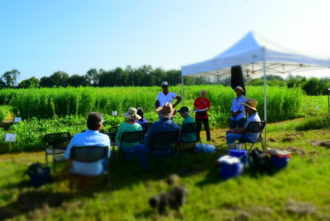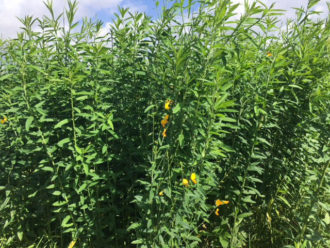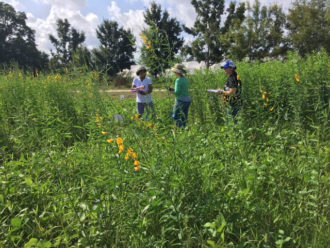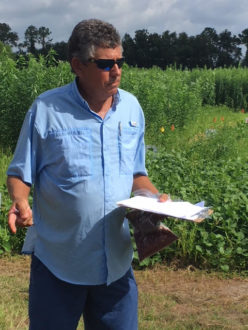HAWTHORNE, Florida – Several new cover crop varieties that have the potential to overcome the limitations of their commercial counterparts are being targeted for use in Florida to provide farmers with a more diverse selection of plants that excel in soil health, weed suppression and pest management.
A small group of farmers, Extension agents and other ag professionals spent an August day evaluating test plots of sunn hemp, cowpea and rattlebox on a USDA-certified organic farm east of Gainesville. The assessment is part of a larger University of Florida study, funded by the Southern Sustainable Agriculture Research & Education (SSARE) program, that is exploring new cover crop varieties that are more adapted to Florida growing conditions, and the Southeast in general.
“We are in the final year of our three-year project, and the idea is to come up with alternative cover crops to more widely available commercial varieties that have performance constraints,” said weed scientist Carlene Chase.
Cover crops have exploded in recent years across the Southeast as a more sustainable tool to maintain soil health, fight erosion, manage weeds and pests, and provide forage for livestock, among other benefits. Sunn hemp and cowpea are of particular interest to Florida producers because of high biomass production and the ability to fix nitrogen in the soil. However, commercial varieties have some performance constraints.
Sunn hemp, a fast-growing tropical legume noted for its high biomass and good nutrition content as a forage, is a short-day plant – meaning that it only forms flowers when day length is less than 12 hours.
“This means that short-day types of sunn hemp do not set seed in the U.S., and farmers have to keep importing it,” said Chase. “There is one day-neutral sunn hemp variety available – AU Golden, but we found that here in Florida is does not produce very high biomass.”
Through a $201,249 SSARE Research & Education Grant (LS16-270), “Cover Crop Diversity Through Evaluation and Increase from Breeder Stocks and Germplasm Repositories,” researchers are evaluating other sunn hemp varieties not yet commercially available that perform like AU Golden, but produce more biomass. The plots are located at Frog Song Organics in Hawthorne, FL – a USDA-certified organic vegetable farm where owner John Bitter has been using cover crops for several years.
So far, said Chase, one sunn hemp accession stands out: PI 426626, also known as Sanni. In the field plots at Frog Song Organics Sanni is growing so dense that one could get lost in it – and in early August it’s already flowering. Chase hopes to collect seed from Sanni so that farmers have a more viable sunn hemp variety to use in Florida.
“Sanni, so far, is a good option in terms of high biomass and producing seed in the U.S.,” said Chase.
Researchers are also exploring cowpea varieties at Frog Song Organics. Cowpea is popular as a forage legume because of its adaptability to the heat and its ability to thrive in sandy soils.
“But cowpea can get weedy if it gets away from the farmer and produces seed,” said Chase. “Clemson developed new lines that don’t have that problem. We wanted to test those varieties in the study for weed suppression.”
In the first two years of the trials we did not see good results from the cowpea because we didn’t have the seed count high enough,” said Chase. “This year we bumped up the cowpeas to 75 seeds per square meter and we are seeing good results.”
Rattlebox, a perennial legume native to southeastern U.S., is being evaluated as a cover crop for its ability to resist sting nematode.
“Farmers don’t have a lot of crop rotation options and rattlebox just increases that diversity and adds another tool to the cover crop toolbox,” said Chase.
On a separate farm, researchers are also evaluating hairy indigo to determine if cultivars are available that can overcome the plant’s low germination rates.
“Involving growers in seed multiplication and field evaluation of the improved hairy indigo selections, as well as the cowpea lines and the sunn hemp varieties discussed will promote greater seed availability and improve the prospects for commercialization and adoption of new cover crop options,” said Chase.
Farmers who attended the Frog Song Organics cover crop field day were impressed with what they saw.
“Cover crops are an integral part of any organic operation,” said Bitter. “Seeing how the different varieties perform in a research study just increases the validity of their use on the farm.”
Ed James, a citrus grower in Leesburg, FL, has been playing with cover crop mixes for several years – cover crops such as sunn hemp, millet, buckwheat, oats, cowpea, daikon radish, and clover. He uses cover crops for their ecological services and is always looking for a new variety to add to the mix.
“I’ve been intercropping cover crops with the citrus grove, growing them as living mulches or smother crops,” said James. “Cover crops have reduced my fertilizer costs significantly and improved the health of my soil, and subsequently, the health of my citrus trees.”
James is convinced that cover crops are a key piece of managing citrus greening.
“You fix the soil, you fix your trees,” he said.
Published by the Southern Region of the Sustainable Agriculture Research and Education (SARE) program. Funded by the USDA National Institute of Food and Agriculture (NIFA), Southern SARE operates under cooperative agreements with the University of Georgia, Fort Valley State University, and the Kerr Center for Sustainable Agriculture to offer competitive grants to advance sustainable agriculture in America's Southern region. This material is based upon work that is supported by the National Institute of Food and Agriculture, U.S. Department of Agriculture, through Southern Sustainable Agriculture Research and Education, under sub-award number: LS16-270. USDA is an equal opportunity employer and service provider. Any opinions, findings, conclusions, or recommendations expressed in this publication are those of the author(s) and do not necessarily reflect the view of the U.S. Department of Agriculture.



